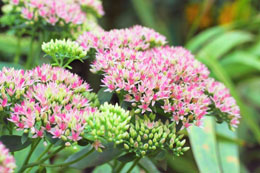Sedums are flowering plants. Sedum plants are quite easy to grow and care. These plants provide bright, deep fall colors to a garden.

Sedum refers to a large group of flowering plants that belong to the family
crassulaceae, which are commonly known as stone crops. There are around 400 species of the leaf succulents varying from creeping herbs to shrubs. But, worry not mentioned below are the different popular varieties of sedums and tips on selecting the right variety. Many sedums are used for gardening or for ornamental purposes. These plants are attractive and very hardy, which makes them ideal for gardens. They have different color foliage and distinctive succulents leaves. One species commonly known as crooked yellow or stone orpine has a slightly astringent sour taste and is used as a salad leaf or herb in Europe and UK. Some species are also used for medicinal purposes. Many species are also used to provide roof covering for green roofs, where they replace the use of grass.
Selection
There are small low-growing ground cover tops to large sedum plants that grow upright to a height of 2 feet or more. These plants come in a wide variety of color too, which includes the leaf and flower colors. The foliage can be green, golden, purple, or red in color. The flowers open in late summer and can be sunny yellow, vibrant gold, orange, pink, soft white, or purple. So, look at different varieties before you decide on the variety you want to grow. Low-growing varieties are very hardy and ideal for rock gardens and as ground cover for borders. These plants prefer full sun, but the low-growing varieties can tolerate shade and so can be planted under trees. Some species of low-growing sedum plants include Dragon's Blood, Mossy Stonecrop, Bainbridge Angelina, and Tricolor. If you are looking for easy to grow sedums which look very attractive, then select the tall upright varieties that produce beautiful flowers. These flowering plants will provide color and interest to your garden during late summer and fall. Some species of such sedums are Abbeydore, Vera Jameson, Autumn Joy, Autumn Fire, and Black Jack.
Plantation
Use a well-drained, hummus-rich organic soil for planting these shrubs and bushes. Sedum tolerates all kinds of soil, except for wet soil. Dig up to two or three feet of soil to aerate and loosen it up, and mix some compost in it. Then dig a hole which is two times the width of your plant's root ball. When planting multiple plants keep a distance of 7 inches to 2 feet between each plant. Place the plant in the hole, ensure that the top of the root ball is in level with the new soil. Press down the soil with your hands and water it.
Care Instructions
Make sure the plant gets at least 2 - 3 hours of sunlight. The soil should be maintained using fertilizers and should be well drained. Keep watering regularly, but make sure the soil is well drained and not overly wet. The flower heads look great during the winter, as they add shade and texture to the plants. During February and March cut back the old flower heads, and apply a generous layer of mulch of well-rotted composting fertilizer at the base of the plant. Once the plant is well established, it will have a tendency to flop leaving an open and unwanted center in fertile soil. To prevent this use Chelsea chop technique. During last week of May, cut one in every three stems back to the ground, this will help to produce plants which are less lush.
So, use the above tips to select the low-growing, ground-covering sedum plants or select a beautiful upright growing flowering sedum plant, and follow the above instructions to care for the plant.






 Sedum refers to a large group of flowering plants that belong to the family crassulaceae, which are commonly known as stone crops. There are around 400 species of the leaf succulents varying from creeping herbs to shrubs. But, worry not mentioned below are the different popular varieties of sedums and tips on selecting the right variety. Many sedums are used for gardening or for ornamental purposes. These plants are attractive and very hardy, which makes them ideal for gardens. They have different color foliage and distinctive succulents leaves. One species commonly known as crooked yellow or stone orpine has a slightly astringent sour taste and is used as a salad leaf or herb in Europe and UK. Some species are also used for medicinal purposes. Many species are also used to provide roof covering for green roofs, where they replace the use of grass.
Sedum refers to a large group of flowering plants that belong to the family crassulaceae, which are commonly known as stone crops. There are around 400 species of the leaf succulents varying from creeping herbs to shrubs. But, worry not mentioned below are the different popular varieties of sedums and tips on selecting the right variety. Many sedums are used for gardening or for ornamental purposes. These plants are attractive and very hardy, which makes them ideal for gardens. They have different color foliage and distinctive succulents leaves. One species commonly known as crooked yellow or stone orpine has a slightly astringent sour taste and is used as a salad leaf or herb in Europe and UK. Some species are also used for medicinal purposes. Many species are also used to provide roof covering for green roofs, where they replace the use of grass.